Since we first moved to the farm, each year, around mid-late winter, I’d occasionally see a flash of copper and green whiz past me in the garden. Only catching a glimpse out of the corner of my eye, I assumed they were simply migrating Rufous Hummingbirds (Selasphorus rufus) passing through.
Then last April, every time I walked down the farm road, near a particular live oak, I’d predictably get dive-bombed, and chirped at, by a very agitated hummingbird.
I spent some time watching to see where this bird would land, and eventually she landed squarely in her nest. If I hadn’t been watching her closely, I never would found the nest. It turns out that at least some of these streaks of copper and green weren’t Rufous hummingbirds after all.
The Allen’s hummingbird (Selasphorus sasin) is very similar in appearance to the Rufous, sharing the same overall coloration. One key distinguishing characteristic though is that Rufous hummingbirds don’t nest here.


Their breeding grounds are much further north. The fact this bird was nesting here at the farm helped me to distinguish this female was indeed an Allen’s hummingbird.
Sadly, as happens so often here with the farm’s predators, those nestlings did not survive to fledging, and that was the last I saw of the Allen’s hummingbirds last year.
Usually the Anna’s hummingbirds are the most common species sighted here, especially in the summer and fall as they zip around the native Salvias, and Epilobiums.
Over the last two years though we’ve been noticing quite a few more Allen’s hummingbirds, especially in the spring.
Then toward the end of February, just a few weeks ago, as I was heading up to collect the hen’s eggs, I noticed a hummingbird was spending a lot of time hovering around near the office. Every day I’d walk outside, and there she was zipping around, and I wondered if she too might be nesting.
I stepped back a few feet, and stood and watched for a while. My patience was rewarded when after a few minutes she finally flew directly into her nest. I was a little surprised, as it was a full seven weeks earlier than I’d seen the nest last year.

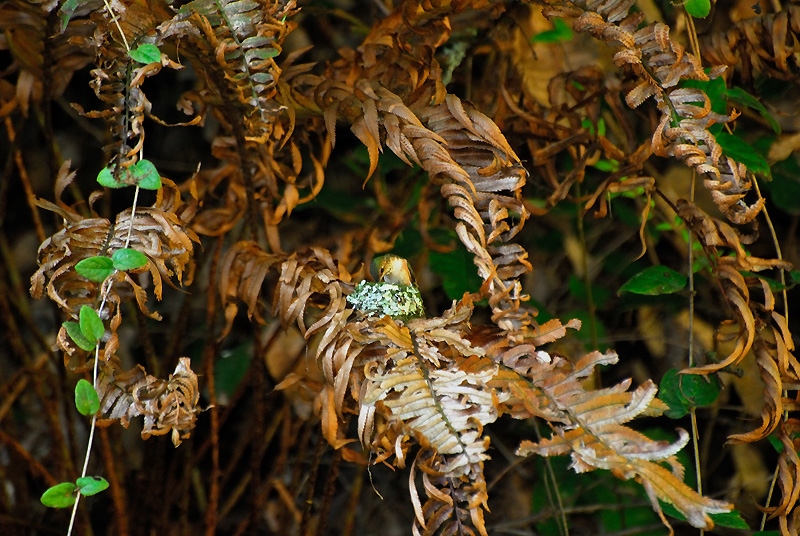
I was also quite surprised to see that this nest was positioned precariously on top of some dead Western Sword Fern (Polystichum munitum) fronds that had been nipped by the frost this winter. I’d been too lazy busy to prune the damaged fronds earlier, and now I’m glad I’d left them alone.
The nest isn’t quite as low to the ground as you might expect, as these ferns are actually growing on a step bank, overhanging one of our drainage culverts. That said though, this nest is about at my eye-level, and I’ve never been accused of being tall.
Over the course of a few days I could see she was still building her nest. Each day a few more pieces of foliose lichen were added to adorn the outside, along with more moss. Then one morning, after I’d brushed out some loose cashmere from the undercoat of the goats, it seemed this little hummingbird was bringing in tiny pieces of goat fluff to line her nest!
Why not? What self-respecting bird wouldn’t want a cashmere-lined nest?
It wasn’t long thereafter that this hummingbird seemed to be squarely settled, and presumably incubating eggs. Incubation for this species usually runs between 16-18 days.
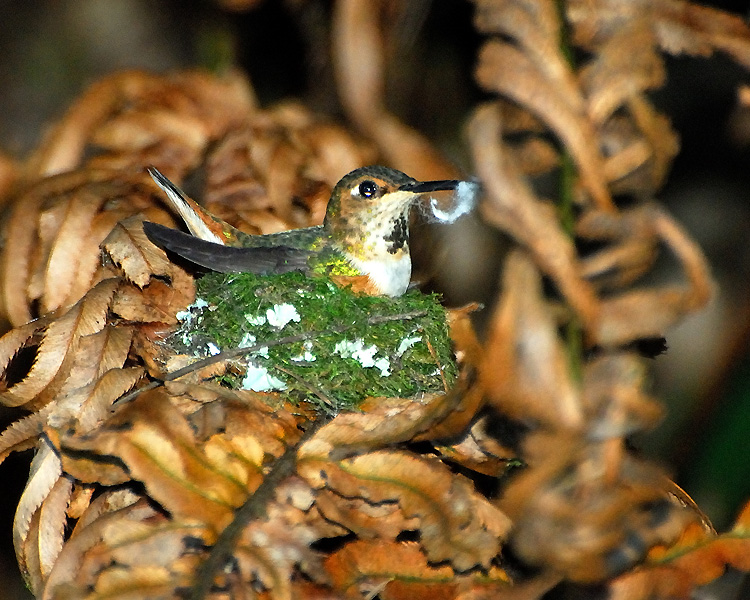
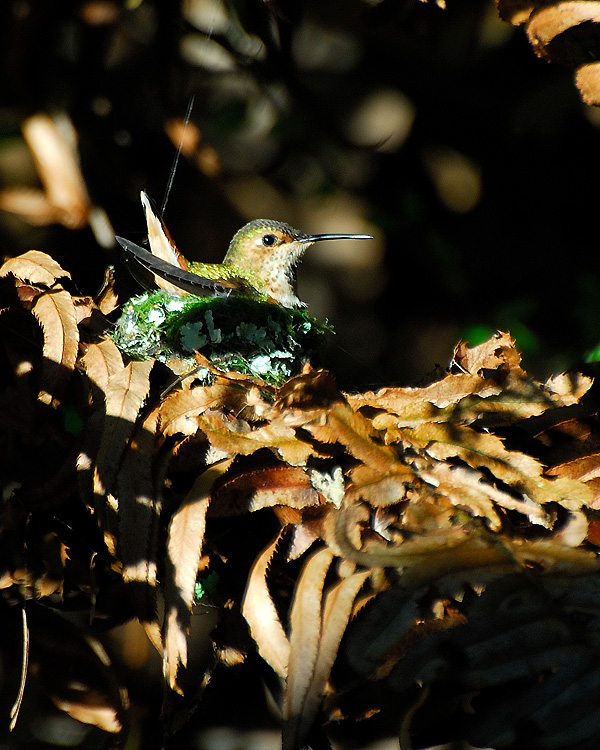

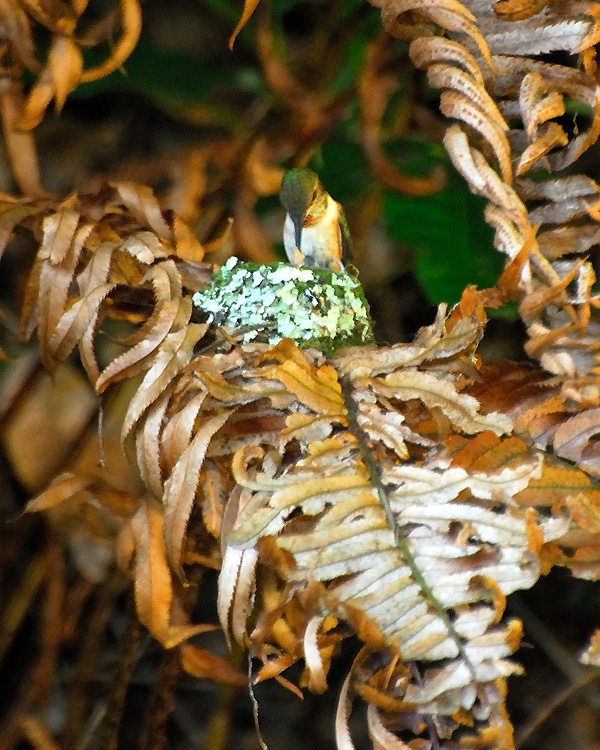
After the first 10 days or so I started spying on her regularly through my binoculars to see if there was any change.
Each time I’d find her hunkered down on the nest.
Then on Tuesday this week I noticed she was absent from the nest more often, and flying around, nectaring on the California Bay Laurels that are currently in bloom.
It’s very difficult to photograph the nest in the afternoons as this slope faces east, and gets quite shady. So on Wednesday morning, quite early, I took my camera out to see if I could observe any change.
I didn’t want to disturb anyone, so I left the tripod behind (hence the less than sharp images), but if you squint, you might just be able to make out that she’s feeding her babies in the image below.
I haven’t been able to count heads yet, but typically this species produces a clutch of 2 eggs.
We love that so many hummingbirds call Curbstone Valley home, and that the Allen’s in particular have been observed nesting here for at least the last couple of seasons. Perhaps they’re attracted by the new nectar sources we’ve planted, or that we opened up the area around the orchard. They do apparently prefer to nest at the edge of open woodland. Or maybe they’re drawn closer to the house since we added a water source in the front garden.
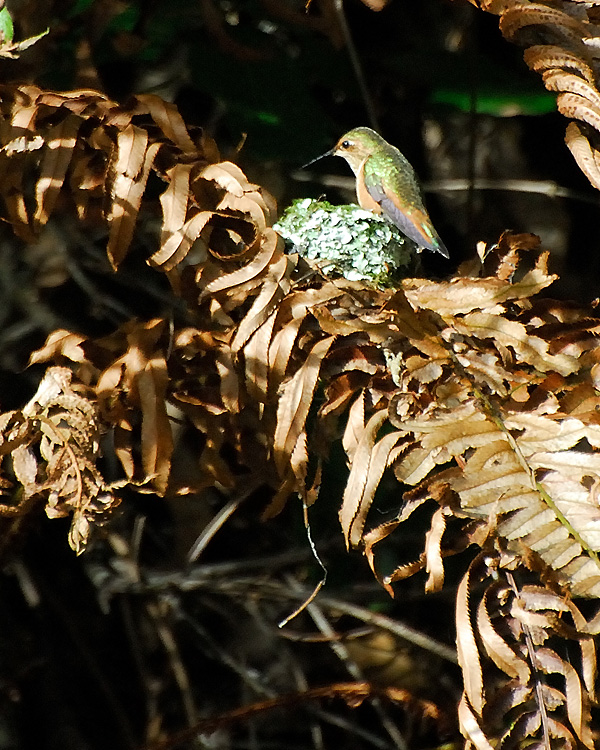
Whatever the reason, it’s so much fun to just look up from my computer monitor, look out the window, and see a nest full of baby hummingbirds.
I hope she has more success than the Allen’s hummingbird I found last year. Although she is somewhat low to the ground, she’s so well camouflaged that some mornings it even takes me a second to find her. So, with luck, the predators won’t be able to find her either!

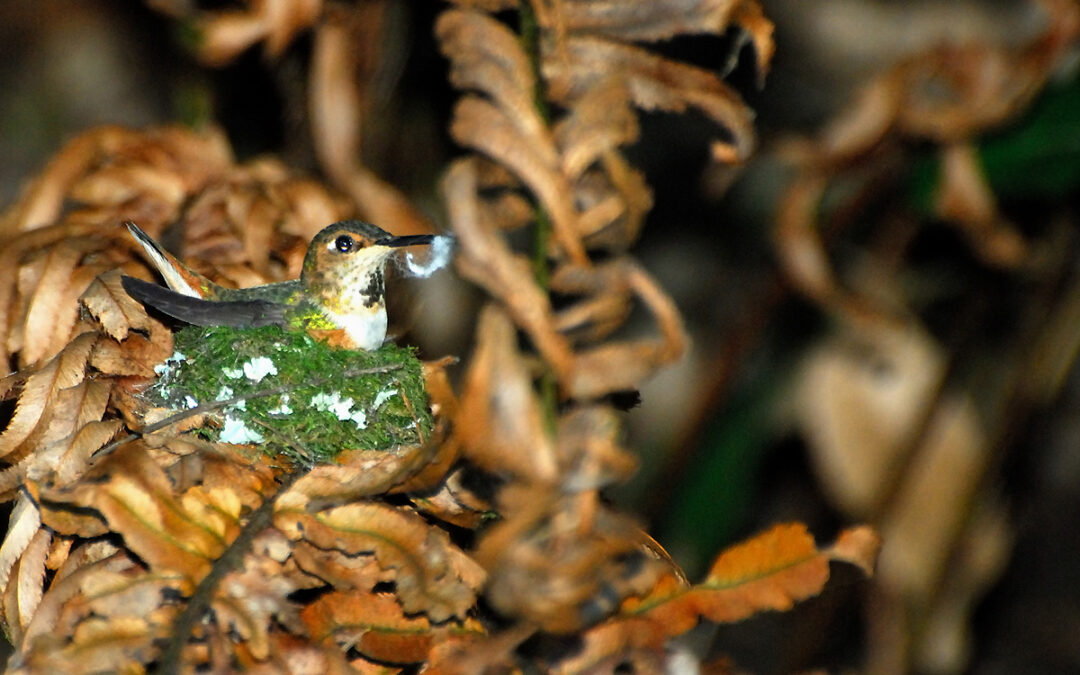

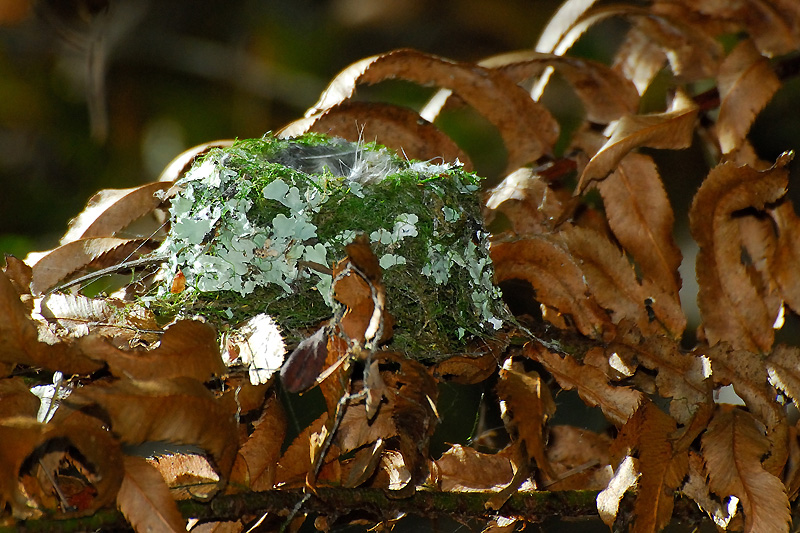
Lettle tiny baby beaks,…I can see them,…
Even with the tripod, Clare, how close do you get to take these photos? You must not breathe….I don’t know how many minutes I’ve stood behind the drapery to catch birds at my birdbath…the hubs laughs at me…. 🙂
Baby birds, baby goats,…Spring is coming!
I’m usually standing at least 30 feet back. I use a 300mm lens. I can only shoot the nest pretty much head on, as from the side there are too many fern fronds, and blackberry vines, that obscure the view. Holding my breath is usually a must! 😛
What a beautiful series of photos! I love the way you share the natural things that are happening around your farm too.
We know you can’t farm and garden without some disturbance to the local ecosystem. However, we do try to minimize those disturbances, and to give something back in the process. Whether it’s planting wildflowers for birds and pollinators, adding stumps and rocks for lizards and salamanders, or building owl boxes, we try to be as unobtrusive as possible. I genuinely find it to be very gratifying when I find something as tiny as a hummingbird nest outside my window, and I love to share! 🙂
Wonderful photos and story. Thanks!
Ann
Thank you, Ann. Glad you enjoyed them.
What good luck – a hummer nest so close like that! Great photos too. I’ve yet to find a hummingbird nest here, though I have seen them before at my old place.
I’ve usually had horrid luck finding hummingbird nests, so two in two years is pretty good for me! I have learned more about some of their behavior clues recently though, and patience is definitely required. Some of these nests are very well hidden!
How exciting! I’ve never seen a hummingbird nest before, and what a beautiful one she has made! Her babies are living in the lap of luxury with cashmere worked into the nest! I hope her and her babies all do well, and make Curbstone their home for many years to come.
It was fun to see the ever-increasing adornments of lichen over the days as she put her nest together. The cashmere was priceless though. Clearly she has very good taste, and it’s been so warm lately, the goats were happy to be rid of it! 😉
This is so exciting! It is amazing how these birds build their nests in some of the most unexpected places and do so well. I hope we will hear good news from you about the baby hummers. Our two rufous are still hanging around but I expect them to depart any day now for their breeding grounds.
I’m crossing my fingers that we see fledglings in the coming days. I suspect we have Rufous hummers here too, passing through, but these two species look so similar on the wing, I’m not sure if I’d ever be able to tell them apart!
Your photos are so incredible, I had to turn around my computer so I could share them with my hubby. He was impressed, too. How wonderful that the hummer found such a great spot for the nest. Thanks so much for sharing all of this!
Awww, thanks! I was actually really frustrated with my camera, wishing I had a much MUCH longer lens. Those babies are so darned tiny. I’ll keep trying for some better baby shots, and once they’re big enough to see in the nest I’ll try and post an update 🙂
Oh, how exciting! I’m found empty nests in my garden, blown down by the wind, but I’ve never actually seen a nest. My hummingbirds seem to prefer spider silk for their nest, so I’m always working hard not to clean the window frames from the outside. (Mr. Mouse does not approve…)
I think this female was using some silk too, to help adhere the moss together. It was interesting to see her nest early on. Much of it is moss, a few small twigs, with lichen on the outside, and then goat fluff, seed fluff, and even a tiny feather lining the inside. What strikes me, too, is that the nest last year, and this year, look almost identical! Birds really are amazing architects!
Oh, and I don’t sweep my spider webs either. I want to encourage the spiders here…they eat flies, and yellow jackets!
Hello Clare! I haven’t visited properly in a little while (but I did have a peek at little Abraham Darby) What a beauty that little hummingbird is, so compact and neat about herself and her nest! I would love to see one with my own eyes one day.
Hi Heidi! Thanks for stopping by. I’m glad you got see little Darby. That poor hummingbird, she did build such a tidy nest, in the middle of yard that has no less than three construction projects going on at once right now. I think she was probably hoping for a better neighborhood 😉
I really enjoyed this post. What a beautiful bird! The nest is quite something too! Your series of photos was fantastic, and makes a great record of such a wonderful event.
I enjoyed finding the nest so early, before she was finished constructing it. It’s been fun to watch her as she so patiently incubated those eggs. 🙂
Clare I love our hummers and miss them…I won’t see them for another month at least…how wonderful to have so many different hummers to watch and see the nest…very special!
Our hummers here have definitely taught me to be patient, at least when it comes to finding nests. But I know we are so very fortunate to have so many here. This is a species, that until we moved here, I wasn’t really aware of, and I love that they seem to love it here!
Had no idea hummingbirds produced such gorgeous nests. Looks extra snug and cosy,
Doesn’t it? It’s so small, it barely seems big enough. I’m sure though, with all that goat fluff, the babies will stay nice and warm!
Oh my gosh I loved reading this…how absolutely wonderful that you get to be part of her world.
We get overwintering Anna’s in White Rock, and in the spring, summer they come up here to the Okanagan, along with the Rufus.
I will try to remember to put out the feeder soon for them.
Jen
I only really notice the Anna’s in the fall here, even though they are supposedly year ’round here. I’m still not entirely sure if I do see Rufous here, as they look so similar to the Allen’s on the wing. I don’t feed ours (other than trying to plant hummingbird friendly plants), as our ants are epic here, and have already over-run one of our hives this year 🙁
I really enjoyed this post, Claire, such lovely photos of such a cute little bird. They do make such darling nests, I saw my first hummingbird nest in St. Lucia. It looked just like that one. They are such good little crafters.
It’s funny how some birds, to our eye, just slap a nest together, and others seem to be meticulous architects. I’d definitely put the hummers in the architect camp. I loved watching, day after day, as the amount of lichen increased on the exterior surface of this nest. She always seemed to primping, and trying to make her nest ‘just-so’. 🙂
What an absolutely perfect little nest that is. and the addition of cashmere, well who wouldn’t want their bed lined with that?
No kidding, except for the goats, I don’t own any cashmere. I’m always afraid of fine wools…as they’re one mis-step through the washer, or heaven forbid, the dryer, from disaster. My clothes have to be more practical here on the farm. I’m definitely a wash-and-wear kind of gal, but I certainly can’t blame her for lining her nest with such finery!
That is so awesome. As far as I know I have only seen Anna’s hummingbirds around here but they zip around so fast I usually don’t get a very good look at them.
That was all I noted here until last spring. The Anna’s, especially the males with their flashy burgundy red throats, were so obvious. I just wrote off that copper flash as migrants. Now I wonder what else I’m missing! I did actually just see my first Varied Thrush here on the farm last week. I’d never noticed one before…and of course…I didn’t have my camera! 😉
Your photos are wonderful, but now I am so worried about whether the baby hummingbirds will make it. The nest seems like it is in such a precarious place. I almost don’t want to know what happens.
I’m totally on edge right now. I am happy to report that as of today, St. Patrick’s Day, all still seems to be well. The female is getting a little miffed with us if we’re out on the patio, but she’s still foraging, and brooding her young. I won’t be happy though until I see her little brood fledge. I hope I have some good news to report in a couple of weeks!
I love hummingbirds. Mine look to be different than yours tho. I keep trying to find nests, but never see them. I hear they are very tiny. Mine have gotten so used to me, I have been able to get them to sit on my finger while they eat from feeder. Check them out at my link above of here: http://tammyinwv.blogspot.com/2010/01/friendly-hummingbirds.html